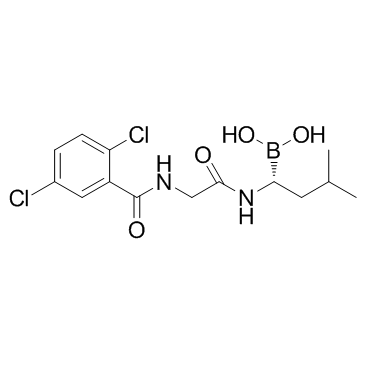1072833-77-2
| Name | [(1R)-1-[[2-[(2,5-dichlorobenzoyl)amino]acetyl]amino]-3-methylbutyl]boronic acid |
|---|---|
| Synonyms |
B-{(1R)-1-[2-(2,5-dichlorobenzamido)acetamido]-3-methylbutyl}boronic acid
N-(2,5-Dichlorobenzoyl)-N-[(1R)-1-(dihydroxyboryl)-3-methylbutyl]glycinamide [(1R)-1-[[2-[(2,5-dichlorobenzoyl)amino]acetyl]amino]-3-methyl-butyl]boronic acid MLN2238 ixazomib Boronic acid, B-[(1R)-1-[[2-[(2,5-dichlorobenzoyl)amino]acetyl]amino]-3-methylbutyl]- Ixazomib B-[(1R)-1-[[2-[(2,5-dichlorobenzoyl)amino]acetyl]amino]-3-methylbutyl]boronic acid |
| Description | Ixazomib (MLN2238) is a selective, potent, and reversible proteasome inhibitor, which inhibits the chymotrypsin-like proteolytic (β5) site of the 20S proteasome with an IC50 of 3.4 nM (Ki of 0.93 nM). |
|---|---|
| Related Catalog | |
| Target |
IC50: 3.4 nM (20S proteasome)[1] Ki: 0.93 nM (20S proteasome)[1] |
| In Vitro | Ixazomib (MLN2238) is an N-capped dipeptidyl leucine boronic acid and preferentially bound to and inhibited the chymotrypsin-like proteolytic (β5) site of the 20S proteasome with an IC50 value of 3.4 nM (Ki of 0.93 nM). At higher concentrations, Ixazomib (MLN2238) also inhibits the caspase-like (β1) and trypsin-like (β2) proteolytic sites (IC50 of 31 and 3,500 nM, respectively). Cell viability studies are performed in a variety of mammalian cell lines to compare the in vitro antiproliferative effects of Ixazomib (MLN2238) with Bortezomib. Studies performed with A375 (lung), H460 (lung), HCT-116 (colon), and HT-29 (colon) cells revealed similar LD50 values for the two compounds, which range from 4 to 58 nM[1]. |
| In Vivo | Ixazomib (MLN2238) shows antitumor activity in the CWR22 xenograft model. The antitumor effects of Ixazomib (MLN2238) dosed at 14 mg/kg i.v. or 7 mg/kg i.v. are compared with Bortezomib dosed at 0.8 mg/kg i.v. or 0.4 mg/kg i.v. on a twice weekly regimen. The high dose for both Ixazomib (MLN2238) and Bortezomib shows similar antitumor activity in this model (T/C=0.36 and 0.44, respectively). However, Ixazomib (MLN2238) (7 mg/kg) shows greater efficacy at a 0.5 MTD dose compared with a 0.5 MTD dose of Bortezomib (0.4 mg/kg; T/C=0.49 compared with T/C=0.79, respectively) Ixazomib (MLN2238) shows time-dependent reversible proteasome inhibition; however, the proteasome dissociation half-life (t1/2) for Ixazomib (MLN2238) is determined to be 18 minutes[1]. |
| Cell Assay | Calu-6 cells are cultured in MEM containing 10% fetal bovine serum and 1% penicillin/streptomycin and plated 1 d before the start of the experiment at 10,000 cells per well in a 384-well plate. For IC50 determinations, cells are treated with varying concentrations of Bortezomib or Ixazomib in DMSO (0.5% final, v/v) for 1 h at 37°C. For reversibility experiments, cells are treated with either 1 μM Bortezomib or Ixazomib (MLN2238) for 30 min at 37°C and then washed thrice in medium to remove the compounds. Cells are incubated for an additional 4 h at 37°C, after which the medium is removed and replaced with fresh medium. Proteasome activity is assessed by monitoring hydrolysis of the chymotrypsin-like substrate Suc-LLVY-aminoluciferin in the presence of luciferase using the Proteasome-Glo assay reagents. Luminescence is measured using a LEADseeker instrument[1]. |
| Animal Admin | Mice[1] Male CB17-SCID mice, approximately 8 to 11 wk of age, are inoculated s.c. with freshly dissected CWR22 tumor fragments (~20 mg) in the right dorsal flank. Mean tumor volume (MTV) is calculated using the following formula: 0.5×(length×width2). When MTV reaches approximately 150 to 200 mm3, animals are randomized into treatment groups (n=10 per group) before dosing. Antitumor activity is determined at the end of the study by calculating the treatment over control (T/C) ratio of their MTVs at the end of the study. Rats[1] To determine the pharmacokinetic profile of Ixazomib and Bortezomib in a second species, Sprague-Dawley rats are administered a single i.v. dose of Ixazomib (MLN2238) at either 0.3 or 0.2 mg/kg or Bortezomib at 0.2 mg/kg. Both Ixazomib doses provided a greater plasma exposure (AUC0-48h of 704 and 1,070 h•ng/mL for 0.2 and 0.3 mg/kg doses, respectively) compared with Bortezomib (AUC0-48h of 206 h•ng/mL), confirming that Ixazomib (MLN2238) also has improved plasma exposure compared with Bortezomib in rodents. |
| References |
| Density | 1.3±0.1 g/cm3 |
|---|---|
| Molecular Formula | C14H19BCl2N2O4 |
| Molecular Weight | 361.029 |
| Exact Mass | 360.081482 |
| PSA | 105.64000 |
| LogP | 2.82 |
| Index of Refraction | 1.546 |
| Storage condition | 2-8°C |


